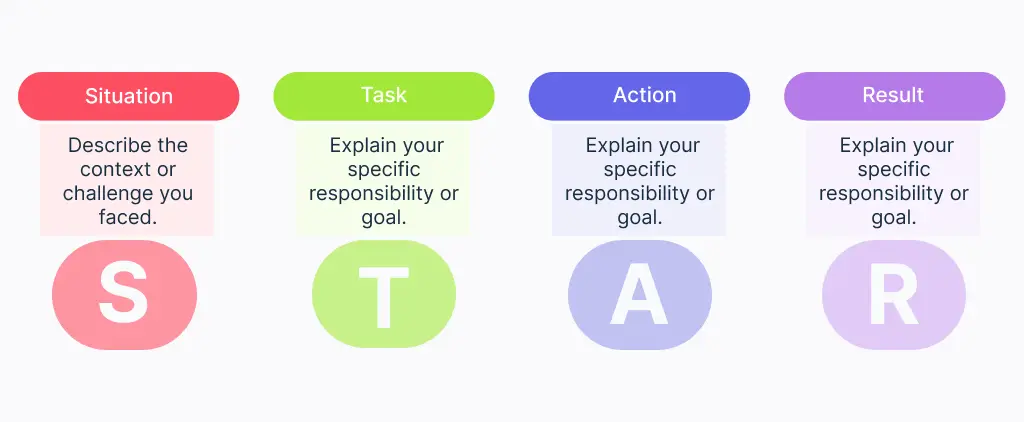Ever found yourself blanking in an interview when asked to “tell me about a time you faced a challenge”? You’re not alone. Behavioral interview questions can be tricky — unless you have a solid framework to guide your answers. That’s where the STAR interview method comes in.
What Is the STAR Method?
The STAR interview method for answering behavioral questions with a clear framework. STAR stands for Situation, Task, Action, and Result. Recruiters and hiring managers often ask competency-based questions to assess past performance; using STAR ensures responses stay focused and concise. This approach emerged in the 1970s and quickly gained traction among talent professionals for its ability to reveal candidates’ problem-solving skills and impact in a structured way.

Breaking Down: Situation, Task, Action, Result
Situation
Begin by setting the scene. Provide concise background information about the project, team, or problem. Specify where and when the event occurred, the environment in which you operated, and any relevant constraints. A clear situation description helps interviewers understand the context and stakes involved.
Task
Clarify the responsibility or challenge assigned to you. Define the objectives you needed to achieve and any expectations or deadlines. For example, you might have been tasked with improving a key process, meeting a sales target, or leading a cross-functional team. The Task section frames your contribution.
Action
Detail the specific steps you took to address the task. Highlight your reasoning, tools, and collaboration efforts. For instance, you might have conducted stakeholder interviews, implemented a new workflow in JIRA, or designed a visual map in Creately. Focus on your individual contributions, even when part of a team.
Result
Quantify outcomes: use metrics such as percentages, dollar amounts, or time saved. Emphasize positive impact on business goals, customer satisfaction, or operational efficiency. For example, “Reduced ticket resolution time by 30% within three months,” or “Increased customer retention by 15%.” Clear results demonstrate the effectiveness of your actions.
How to Prepare Your STAR Method Answers
By identifying key competencies and matching them to your experiences using the STAR method, you build a library of go-to anecdotes that you can draw upon. Preparing STAR format interview answers for multiple scenarios in advance ensures confidence during interviews.
Step 1. Identify Key Competencies
Start by analyzing the job description and noting the core skills and traits the employer is looking for, such as leadership, communication, adaptability, or time management. These are your target competencies. Understanding them helps you tailor your stories to what the interviewer values most. You can also check the company’s career page, mission statement, or recent projects to align your examples even further with their expectations.
Step 2. List Matching Experiences
Once you’ve identified the competencies, think of real situations where you demonstrated each one. Create a table or list with three columns: the competency, the situation, and a short description of what happened. These examples can come from work, internships, volunteer roles, or academic projects. The key is to choose scenarios where your actions made a measurable difference or taught you a meaningful lesson.
Step 3. Map Each Experience to the STAR Framework
Take each example you listed and break it down into the STAR format: Situation, Task, Action, and Result. Ensure each component is well-defined — don’t spend too long on the background, but be specific about your role and what you did. Your “Action” should focus on your personal contributions, and your “Result” should include outcomes, metrics, or lessons learned. This structure keeps your answers clear, concise, and impactful.
Step 4. Prioritize by Relevance and Impact
You likely won’t use every story you prepare, so prioritize the ones that best match the role and showcase your strengths. Choose examples that align with the most important competencies for the position and that have strong, quantifiable outcomes. A well-prioritized story bank helps you respond quickly and confidently, no matter how the question is phrased.
Step 5. Invite Feedback and Rehearse
Practicing your STAR stories out loud is key to sounding confident and natural. Ask a peer, mentor, or friend to listen and offer feedback on clarity, structure, and engagement. They may point out unclear transitions, overused phrases, or missing impact. Rehearsing helps you refine your pacing and get comfortable telling your stories in a conversational tone — not as memorized scripts, but as authentic, well-prepared answers.
Enhance Your STAR Answers with AI-Powered Assistance
Preparing STAR Method responses doesn’t have to be time-consuming. With Creately AI, you can generate structured STAR answers instantly — all from a simple prompt. Just describe your experience in a sentence or two, and the AI will break it down into the Situation, Task, Action, and Result, visually organizing each element into a clean, editable diagram.
This not only saves time but also helps you spot gaps in your story, ensure balance across all four parts, and fine-tune your wording for clarity and impact. Whether you’re refining one answer or building a complete STAR story bank, Creately AI gives you a smarter, faster way to prepare, making your interview practice more interactive, visual, and effective.
STAR Interview Method Templates
Examples for STAR Interview Answers
Here are some examples of using STAR techniques to build your answer.
Sample STAR Interview Answers | ||||
Example | Situation | Task | Action | Result |
Project Leadership Example | The product team faced a critical launch delay due to mismatched stakeholder assumptions. | As the project manager, align cross-functional teams and deliver the launch within the quarter. | Facilitated weekly alignment workshops, mapping dependencies, assigning clear responsibilities, and tracking milestones. | Launched on schedule, increasing initial user adoption by 25% and securing a 10% uptick in sales. |
Customer Resolution Example | A key enterprise client threatened to leave after recurring support delays. | Resolve their issues and rebuild trust within two weeks. | Led a rapid-response team, created a visual escalation workflow, and held daily check-ins with the client. | Reduced ticket backlog by 80%, regained client confidence, and extended the contract for an additional year worth $250K. |
Process Innovation Example | The sales operations team lacked visibility into lead handoff efficiency. | Design a streamlined process to track and improve response times. | Conducted stakeholder interviews, mapped the current and future states, and implemented automated alerts. | Cut lead response time from 48 to 12 hours, boosting qualified lead conversion by 18% and generating $150K in incremental revenue. |
Common STAR Method Mistakes and Tips
Even seasoned candidates can stumble when using the STAR method. Here are some typical missteps and practical tips for stronger responses.
STAR Method Mistakes
- Overloading answers with irrelevant details
- Neglecting to quantify results
- Failing to practice storytelling flow
Tips for the STAR Method
- Focus on the core elements: limit context to 1 or 2 sentences, emphasize your role.
- Include metrics: percentages, timeframes, or monetary figures to demonstrate impact.
- Rehearse aloud, record yourself, and refine transitions between STAR components.
- Keep responses under two minutes, structure each story clearly, and review feedback iteratively to polish your delivery.
Master the STAR Method with Confidence
In this guide, we explored the ins and outs of the STAR Method of interviewing, from understanding each component to preparing compelling responses that impress interviewers. You’ve also learned how to avoid common pitfalls and seen examples of effective STAR answers in action.
Use Creately to visually map out your STAR Method responses. Whether you’re brainstorming past experiences or organizing your thoughts before the big day, Creately helps you structure your answers clearly and confidently.
References
Apple, J.M., Guerci, J.C., Seligson, N.D. and Curtis, S.D. (2020). Adding the second T: Elevating STAR to START for behavioral interviewing. American Journal of Health-System Pharmacy, [online] 78(1), pp.18–21. doi:https://doi.org/10.1093/ajhp/zxaa356.
Villwock, J.A., Hamill, C.S., Sale, K.A. and Sykes, K.J. (2019). Beyond the USMLE: The STAR Algorithm for Initial Residency Applicant Screening and Interview Selection. Journal of Surgical Research, 235, pp.447–452. doi:https://doi.org/10.1016/j.jss.2018.07.057.
The STAR interview technique helps candidates deliver focused answers that showcase key competencies. By following a consistent format, interviewers can quickly gauge relevant skills, and candidates avoid rambling or missing critical details.FAQs about the STAR Method for Interviews
Can I use the STAR Method for any type of interview question?
How long should my STAR Method answers be?
Do I need a different STAR story for every question?
How do I know if my STAR answer is strong enough?
Can the STAR Method help with group or panel interviews?
Why Use the STAR Method in Interviews?






